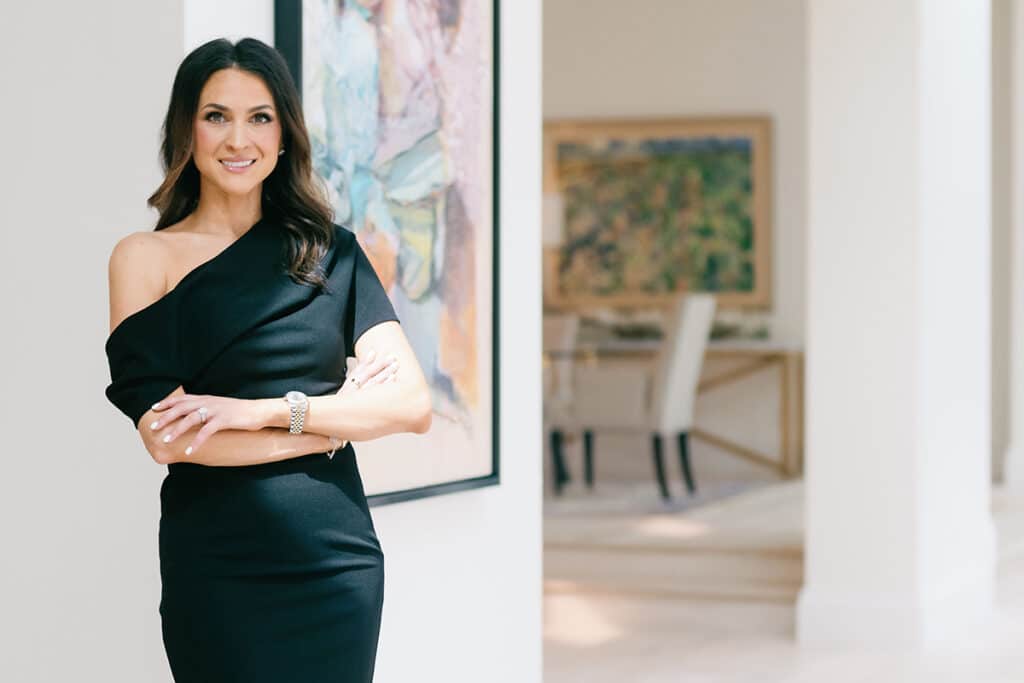The world of real estate development, home building and design is filled with big plans, dynamic projects and busy experts. Behind the earth movers and real estate shakers is a vital support system of professional organizations striving to keep their members informed and their industries strong.
In San Antonio, the day-to-day operations of three of those organizations happen to be managed by women: Becky Oliver of the Greater San Antonio Builders Association, Torrey Stanley Carleton of The American Institute of Architects and Martha Mangum of the Real Estate Council of San Antonio. With nearly 70 years of combined experience, they are adept at juggling all things important to the memberships they serve.
Different facets of the development industry attracted each one. For Carleton, it was architecture. Oliver fervently believes in affordable housing for all. And for Mangum it was people. Together they share a passion for what they do.
Becky Oliver
The quintessential Texan, Becky Oliver has been in the saddle the longest of the three. For the past 37 years, she’s done it all — from building homes to lending money. In fact, she acquired much of her knowledge in the banking industry, where she had oversight responsibility for the real estate, construction and lending arm of a large holding company. She got out of banking in 1986 and started her own publishing company that specialized in publications for the building industry, such as programs for Parade of Homes tours.
So how did she become executive vice president of the Greater San Antonio Builders Association?
Turns out what was to be a temporary situation turned permanent. “Their director left in early 2002, and the officers asked me to take over while they searched for a new one,” says Oliver. “I figured I’d help them out six months, max.” Her company had been publishing the Association’s member roster and other publications for years, so she was well acquainted with the group. “As it turned out, they liked me and I liked them, so we’ve continued!” she explains.
Oliver has always been active within the industry. “It’s been a passion of mine since I graduated from high school,” she says. “I liked the sense of pride that comes from home ownership. A home is such a stabilizing factor for families. Studies show children who come from a family that owns a home are more likely to go to college, have a lower teen pregnancy rate and go on to to be active in their communities.
“I’d always dreamed of owning my own home and wanted my children and grandchildren to have their own too. I want everyone to have the opportunity to forge indelible memories like the ones I had growing up,” comments Oliver.
She spends 70 percent of her time on governmental affairs — anything that affects housing affordability. “A good portion of housing cost increases can be attributed to government regulation,” says Oliver. She gives an example of a proposed requirement to have all new homes chemically treated for termites. “That would cost a builder $300 to $400, and it’s effective for only one year — never mind that new construction normally doesn’t have problems with termites for at least five years. Costs like that get passed right on to the consumer. When you consider that with every $1,000 cost increase, there are 3,800 Texas families being priced out of qualifying for a home, you begin to realize the impact regulations can have.”
In addition to its watchdog role, the Builders Association educates its nearly 900 members on new compliance issues, provides courses for accreditation, sponsors the annual Parade of Homes event (September 4-12 at The Dominion) and works closely with a number of other associations and groups.
“We have a tremendous impact on the city,” says Oliver. “When we go before the city council, we don’t always win, but they listen to us and see the Association as a resource for knowledge. We add a reality check to their considerations. We should have a good working relationship with the city because we work together on issues.”
For those considering the building industry as a career, Oliver says you have to be tough. “I believe it’s a strong and honorable industry. It never escapes me that we provide for one of the most basic human needs — shelter,” she concludes.
Torrey Stanley Carleton
Her interest in architecture began as a child. “I grew up in a house designed by an architect, so early on I had appreciation for design and how it can positively impact your life,” says Torrey Stanley Carleton, executive director of AIA San Antonio, a chapter of The American Institute of Architects. Since she has a degree in art history and a collection of midcentury modern furniture, it appears to be more than serendipity that led her to her current post.
However, Carleton didn’t start with the AIA until 1993. Before that she was responsible for public relations and marketing for the San Antonio Performing Arts Association, a nonprofit arts presenter. The 10 years she spent communicating about cultural and performance events served as an excellent training ground for the many hats she wears today. “It taught me how to multi-task and think about creative strategies for a wide variety of projects simultaneously,” says Carleton.
The thing she loves most about her job with the AIA is the freedom. “Because I have such a supportive board, I can be creative,” she says. “They allow me the flexibility to try new ideas.” The result is Carleton isn’t stymied when it comes to thinking up new ways to demonstrate the value of architecture or working with an architect.
Events like the AIA San Antonio Town and Country Homes Tour, now in its eighth year, are but one example of programs implemented under Carleton’s tenure. The tour, to be held September 18 and 19, showcases the best in custom residential design both in San Antonio and the Hill Country.
In addition to providing basic day-to-day service to more than 400 members, including contract document sales, continuing education classes for architects, seminars for the licensing exam preparation and acting as a job clearinghouse, Carleton and her staff have also taken a positive step to benefit women in the profession.
“As an organization, we’re working to foster opportunities for women within the profession itself,” says Carleton. Two years ago, Women in Design was established. Since architecture has traditionally been a male-dominated field, many felt it was important to provide an extra measure of support and guidance to women. Each month a woman of distinction is invited to share her story of success. Topics have ranged from historic preservation and general contracting specializations to how to keep your creative vision fresh. Presenters tell how they got to where they are today. The meetings are informal so attendees can ask plenty of questions. “Women in Design is a natural network where women can learn about a wide variety of career options — it’s a wonderful exploration,” says Carleton.
“It’s important to have role models and mentors as you go through stages in your career,” she explains. “We hope to strengthen a woman’s ability to move successfully along the track while also adding diversity of thought and approach to the profession itself.”
For women looking to step into the architectural arena, Carleton has some advice: “Find another woman who can be your mentor or role model. Don’t be afraid to ask questions. Get involved in your professional organization because you’ll become stronger by reaching out and stretching with others.” And finally, and perhaps most importantly, “Believe in yourself.”
Martha Mangum
Mangum acquired her focus for the commercial side of real estate and development when she moved to San Antonio in the early ’80s and went to work for real estate developer Walter Embrey. At the time, Embrey was volunteer president of the National Association of Industrial and Office Parks. When the real estate market went downhill, the local chapter of NAIOP decided to do what Austin and Dallas had done — form a locally funded real estate council rather than spend money on dues that went to the national organization. The Real Estate Council of San Antonio was born in 1991 and had 30 to 40 member companies. That’s when Martha Mangum became executive director. Today, there are more than 240 member companies, with 650 developers, brokers, property owners, lenders, lawyers, engineers and general contractors participating.
The Real Estate Council’s main focus is the commercial end of building and development. “Our mission is to advocate for professionals in the real estate industry. We educate members and influence action to ensure a healthy economy and enhanced quality of life in our community,” says Mangum. “That takes a lot of reaching out and teamwork among various groups and interests.” As a result, communication is a major part of Mangum’s job.
Just what is she communicating? “Our industry is one of the most regulated – since 1992 we’ve absorbed more than 20 new regulations,” says Mangum. The development process is already complex, so changes in city policies or regulations can make it that much harder to navigate. “We’re constantly updating our membership, in addition to providing development process seminars,” she says.
That’s not to say passivity is in Mangum’s vocabulary. She continually monitors and works on a variety of issues, making sure the interests of the membership are represented. She reaches out to a variety of groups through task forces and committees to help ensure that city and government agencies develop balanced and reasonable regulations. She coordinates regular Business Coalition meetings where trade associations, chambers of commerce and others work on big-picture issues in San Antonio, such as charter reform and the PGA golf course.
“A highly regulated environment drives up costs for the consumer,” she points out. “We strive to influence the process to keep the interests of the public and private sectors balanced. The ultimate goal is to make sure San Antonio continues to be a desirable place to live and work.”
Getting together for growth
“We don’t want San Antonio to end up in the same boat as Austin,” says Becky Oliver, executive vice president of the Greater San Antonio Builders Association. “Over-regulation strangles growth by making the building and development process so complex and expensive that builders move their projects outside of city limits.” That means people are using city infrastructure, like streets, to commute to work, but the tax base that is supposed to support that infrastructure is being created outside the city.
Regulations on tree preservation, sidewalks, street widths, signage, storm drainage, traffic design and habitat have gradually increased costs and lengthened the permit process, industry officials say.
Oliver and others within the building and development industry are so adamant about the issue of over-regulation that they formed the Responsible Growth Alliance. The coalition that forms the Alliance is the broadest assembly of real estate-related business people and associations in any Texas city. It’s comprised of contractors, developers, land investors, real estate brokers and attorneys, escrow agents, architects, engineers and property managers. The San Antonio chapter of The American Institute of Architects, the Real Estate Council of San Antonio and the Greater San Antonio Builders Association are active participants, in addition to many other related organizations.
Thus far the Alliance has focused its efforts on education, mainly through disseminating data from an economic impact study it released in February. The study, created by Austin-based economist John Hockenyos, showed that the industry accounts for $9.4 billion annually in Bexar County — topped only by the health care industry’s $11.5 billion impact and well ahead of tourism’s $7.2 billion. Hockenyos estimated that the development industry contributed $96.7 million in local tax revenue in 2001 and provided more than 86,000 jobs. The construction sector alone, with more than 36,000 jobs, was the fifth-largest employer.
Author: Kelly A. Goff
Photographer: Janet Rogers




